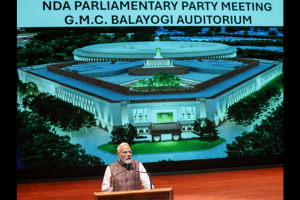On the auspicious occasion of Ram Navami, Prime Minister Narendra Modi is set to inaugurate India’s first vertical lift sea bridge, the New Pamban Bridge, in Ramanathapuram, Tamil Nadu, on Sunday.
Spanning 2.07 kilometers across the Palk Strait, the New Pamban Bridge marks a major milestone in India’s infrastructure journey, blending engineering excellence with future-ready design. According to a statement by the Ministry of Railways, the bridge stands as a testament to India’s commitment to innovative, resilient, and sustainable connectivity.
The bridge includes a 72.5-meter vertical lift span capable of allowing ships to pass underneath, and is built to accommodate two railway tracks. The approach features 88 spans with 18.3-meter steel plate girders, all fabricated for a single rail line.
The original Pamban Bridge, built in 1914 by British engineers, was a cantilever structure with a Scherzer rolling lift span. It served as a crucial link between Rameswaram Island and mainland India for over a century. However, due to corrosion and rising transport demands, it was closed in 2022. The new bridge, approved in 2019, is 3 meters higher than its predecessor, ensuring improved sea connectivity and navigability.
Constructed by Rail Vikas Nigam Limited (RVNL), a Navratna PSU under the Ministry of Railways, the bridge is designed to handle higher speeds, increased loads, and complex maritime traffic. It incorporates stainless steel reinforcement, high-grade protective paint, and fully welded joints to ensure safety and longevity in the harsh marine environment. A special polysiloxane coating adds an extra layer of corrosion resistance.
“The increasing volume of traffic and the need for faster, safer, and more durable connectivity led to the conception of this technologically advanced bridge,” said the Ministry. The structure addresses both modern transportation needs and the challenges posed by the region’s seismic activity, cyclones, and corrosive climate.
The construction of the bridge came with its share of challenges—from turbulent waters and strong winds to unpredictable weather and logistical constraints. To overcome these, engineers used cutting-edge techniques such as the ‘Auto Launching Method based on Relationship Principle’, designed by Suntech Construction Engineering Consultants and validated by IIT Madras.
Segment transportation and assembly were handled with precision. After thorough painting and inspection, bridge components were transported to the site, where a temporary platform with two EOT (Electric Overhead Traveling) cranes enabled girder assembly. Welds were performed in climate-controlled huts and inspected using Phased Array Ultrasonic Testing (PAUT) before undergoing corrosion protection with metalizing and specialized paints.
While the New Pamban Bridge is a first for India, it joins the ranks of iconic global structures like the Golden Gate Bridge (USA), Tower Bridge (London), and the Oresund Bridge (connecting Denmark and Sweden), reflecting India’s growing expertise in world-class infrastructure development.
Beyond its technological significance, the bridge is expected to boost regional trade, tourism, and pilgrimage, strengthening the economic fabric of southern India and enhancing connectivity to Rameswaram—one of Hinduism’s most sacred sites.
With this inauguration, PM Modi not only marks the celebration of Lord Ram’s birth but also showcases India’s forward momentum in nation-building and engineering excellence.





